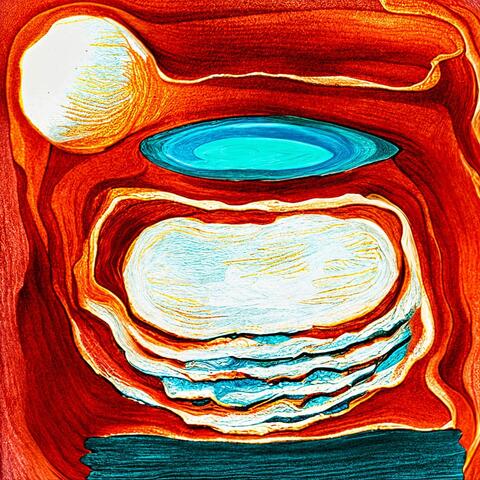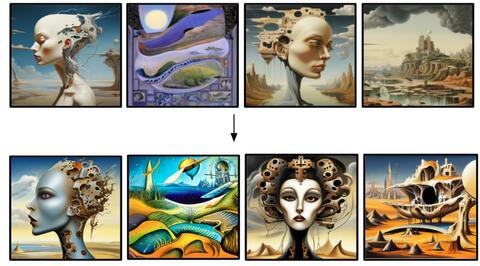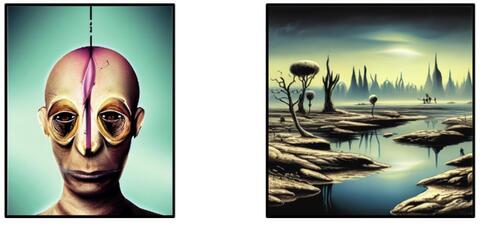
When AI Reveals Human Imagination
With their latest exhibition IMAGINE, the digital art trio Obvious—whose research lab is affiliated with SCAI—pushes the boundaries between art and science. Through a series of works created directly from brain activity, this collective pioneers a new form of artistic expression, offering an unprecedented exploration of the connections between human imagination and artificial intelligence.
© OBVIOUS-Soft as a Cactus, 2024
Two-layer Digigraphie® print on cotton texture paper, 4-Blacks deep overprint
A Revolution at the Intersection of Art, AI, and Neuroscience
After gaining attention in 2018 by selling an artwork generated by AI software at Christie’s in New York, the Obvious collective has reached a new milestone in the history of art. Their IMAGINE project, created in collaboration with neuroscience and AI, uses functional MRI (fMRI) imaging to capture the artists' brain activity while they imagine paintings, and algorithms to reconstruct these mental images.
In a resolutely scientific approach, Obvious partnered with researchers at the Sorbonne University Brain Institute to carry out this project. This collaboration was essential in developing protocols to capture and interpret artists’ brain data. “The Brain Institute provided us with access to MRI and helped refine our project. We worked with Alizée Lopez-Persem, a cognitive neuroscience researcher in the Frontlab team, to better understand the mechanisms of creativity and how different areas of the brain are activated during image visualization and imagination. Without the contribution of these scientists, it would have been impossible to push our artistic approach this far,” says Hugo Caselles-Dupré, a member of the collective and a PhD in machine learning.
From Imagination to Image: A Rigorous Experimental Process
The protocol that allowed Obvious to achieve this symbiosis between AI and the human brain consists of three stages. First, the artists were placed in an fMRI scanner and exposed to over 1,000 surreal portraits and landscapes. “The goal was to identify which regions of the brain were activated in response to viewing these different types of images,” explains Caselles-Dupré. During this phase, fMRI data is collected to map the activated areas precisely. Each image type is associated with a specific brain activation pattern, creating a “library” of neural responses based on visual stimuli. This information trains the AI algorithm to reconstruct these images.
In the second stage, images are shown to the artist for a very brief time (less than a second). “The objective here is to capture brain activation patterns during internal visualization, without external stimuli. Imagination involves regions similar to those activated by visual perception and many additional cognitive networks, such as those linked to memory,” Caselles-Dupré adds.

En haut : images issues du jeu de données d'images surréalistes, remémorées par le sujet dans l'IRMf. En bas : images reconstruites par le modèle IRMf-to-Image, basé sur les données cérébrales associées à la remémoration des images précédentes. ©Obvious
In the final stage, the artist entirely imagines a painting (portrait or landscape) based on poetic descriptions from automatic writing exercises. “This phase requires more advanced cognitive engagement since one must build an image from memory and imagination without any visual aid,” adds the artist. The AI then uses this brain data to translate these abstract thoughts into concrete images through the “fMRI-to-Image” model. These images are then printed in deep blacks on textured paper to give the works vibrant colors.

Images reconstruites par le modèle à partir de l'activité cérébrale d'un sujet qui a reçu l'instruction dans l'IRMf : "Imaginez un portrait et un paysage représentant la tristesse" © Obvious
Overall, each member of the collective spent between 8 and 10 hours in the MRI—a highly challenging experience for Caselles-Dupré: “Remaining perfectly still while our brains are being scanned feels like becoming just eyes in a machine,” he admits. This physical and mental commitment to the project recalls the necessary involvement of the artist’s body in the creative process.
From Surrealism to Neuro-Surrealism
Through this experimental and artistic approach, Obvious has uncovered a previously unexplored realm of creative expression. This innovative method aligns with surrealist experiments. Drawing inspiration from 20th-century practices of psychic automatism, such as automatic writing and the cadavre exquis, the artists aim to visually represent the mind’s unconscious creations using 21st-century tools. “We realized that there’s a direct link between what the Surrealists were doing a hundred years ago and what we’re trying to do today with modern technologies,” explains Caselles-Dupré. “Like them, we seek to free the imagination and unlock the unconscious. Where they used automatic writing, we use AI to give tangible form to inner visions.”
The trio sees themselves as “neuro-surrealists” and views this collaboration between humans and machines as a way to transcend the limits of art. “AI doesn’t surpass human creativity; it amplifies it. It opens new paths to express what we could only dream of before,” says Caselles-Dupré.
Towards New Forms of Communication?
By pushing the limits of what is possible, Obvious invites us to rethink our understanding of imagination, creativity, and consciousness itself, while confronting the ethical and societal challenges these new technologies raise. “AI is reaching a maturity level where it enables crucial advances in interdisciplinary fields, like neuroscience. With these tools, we can read thoughts more precisely and reconstruct mental images,” says Caselles-Dupré. He mentions the possibility of developing brain-machine interfaces that allow for more direct and efficient communication than speech or writing. “If we could perform the act of reading or writing directly through the brain automatically, it would change the entire communication of our species,” he explains.
This perspective also raises important ethical questions about the potential use of these technologies. “There’s a risk of misuse, such as reading minds or for advertising purposes. But if well-regulated, they could also be beneficial, for instance, in communicating with people in comas,” notes the artist.
Art as a Catalyst for Scientific Progress
More than just an exhibition, IMAGINE is an invitation to rethink our relationship with technology, both as a tool and a mirror of our inner worlds. “This project shows that art and science can not only coexist but also enrich each other, paving the way for a new humanity where the line between imagination and reality becomes increasingly blurred,” emphasizes Caselles-Dupré.
Convinced that art can serve as a catalyst for scientific and technological innovation, the Obvious collective plans to continue and deepen their research with a larger-scale scientific study to better understand the brain mechanisms involved in the IMAGINE project.
Discover the Imagine exposition at the Daysz Gallery, before it closes on the 9th of November.
Par Justine Mathieu
